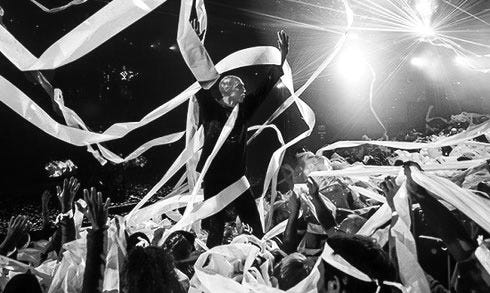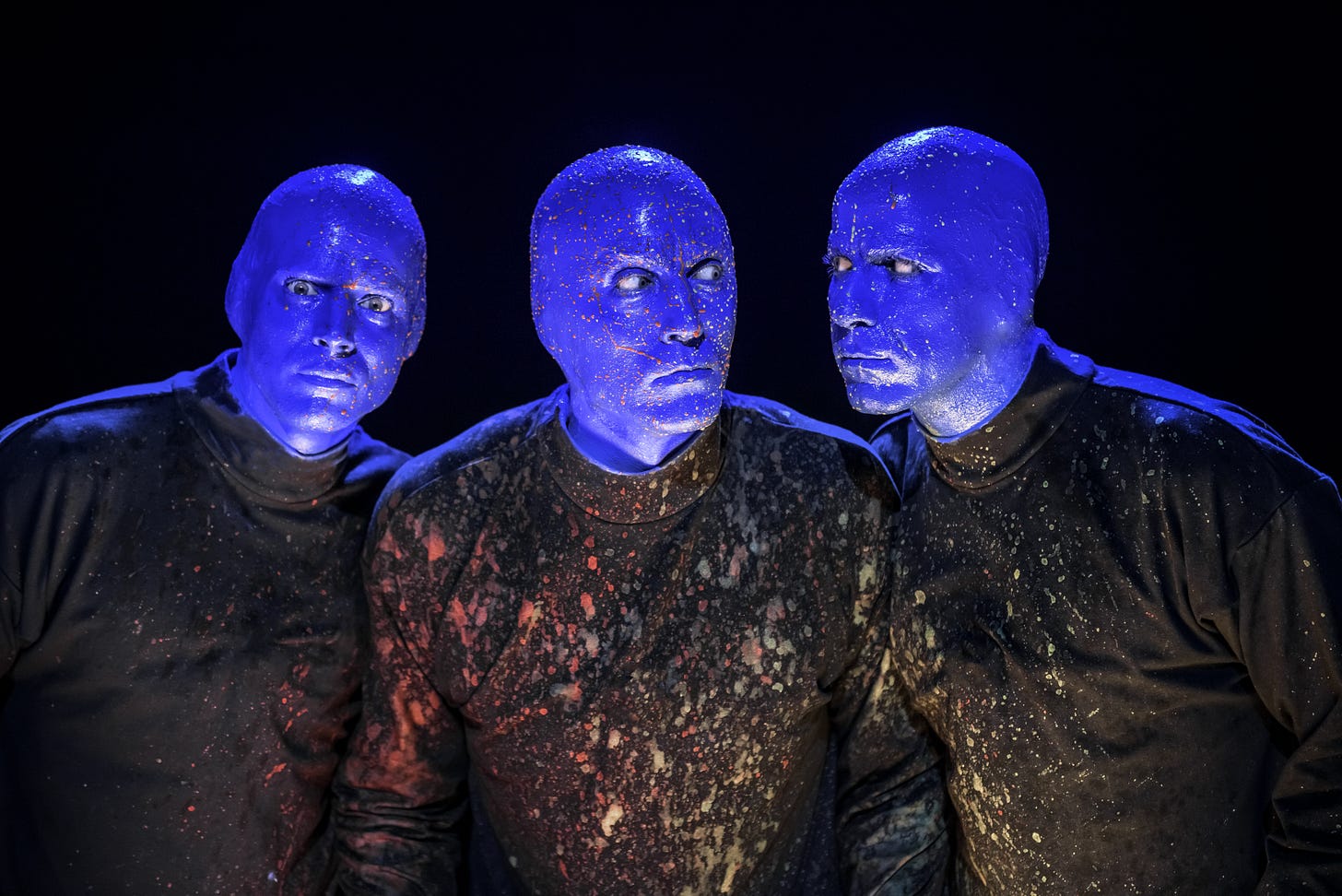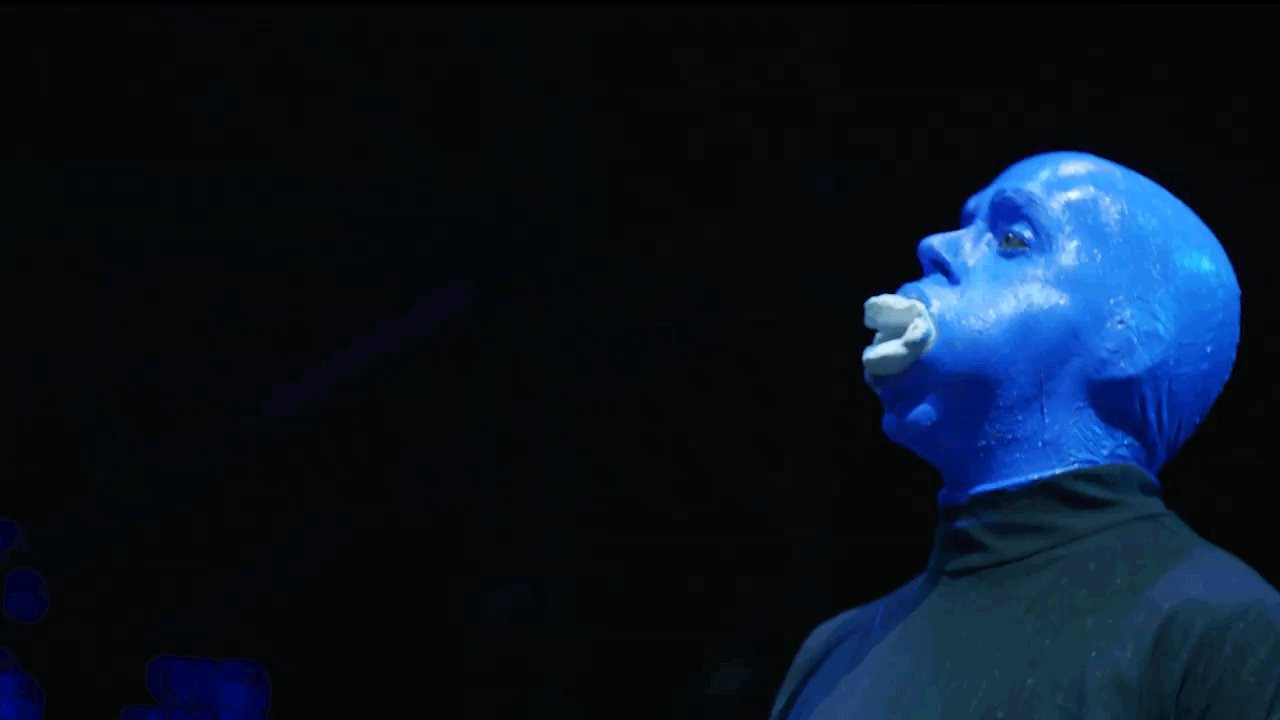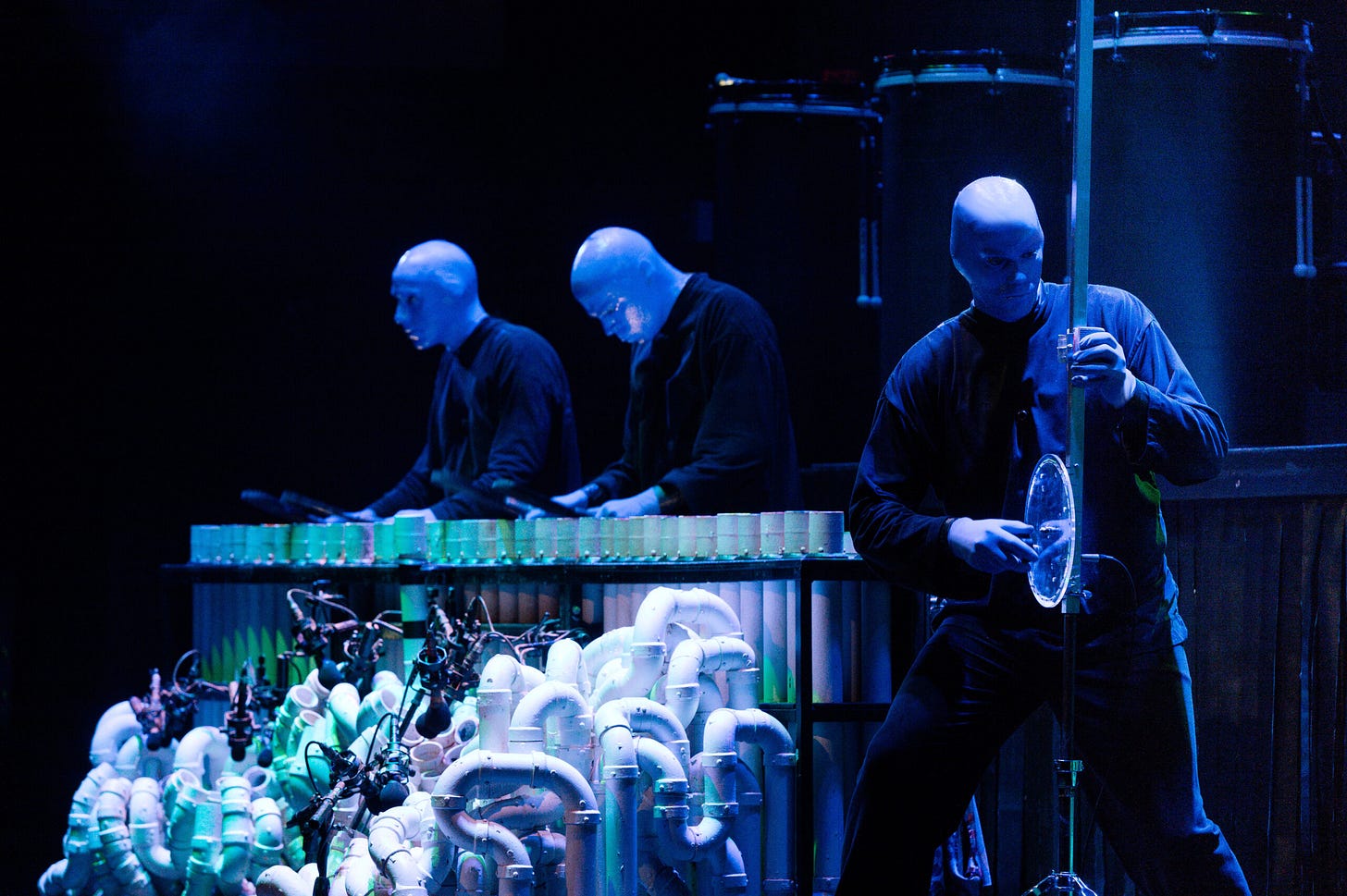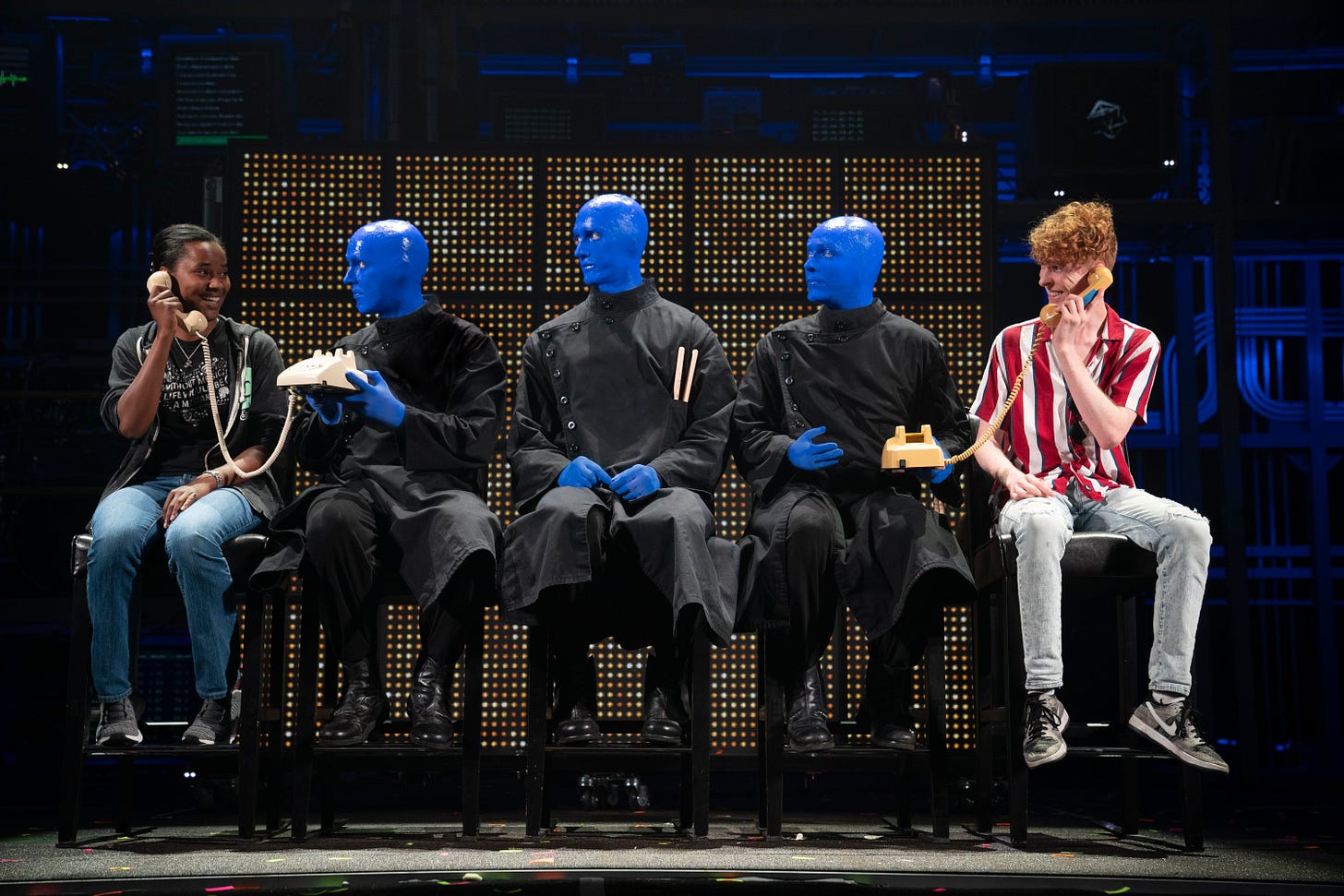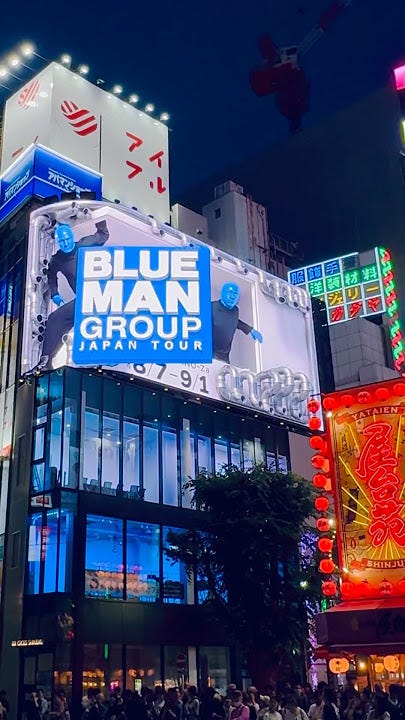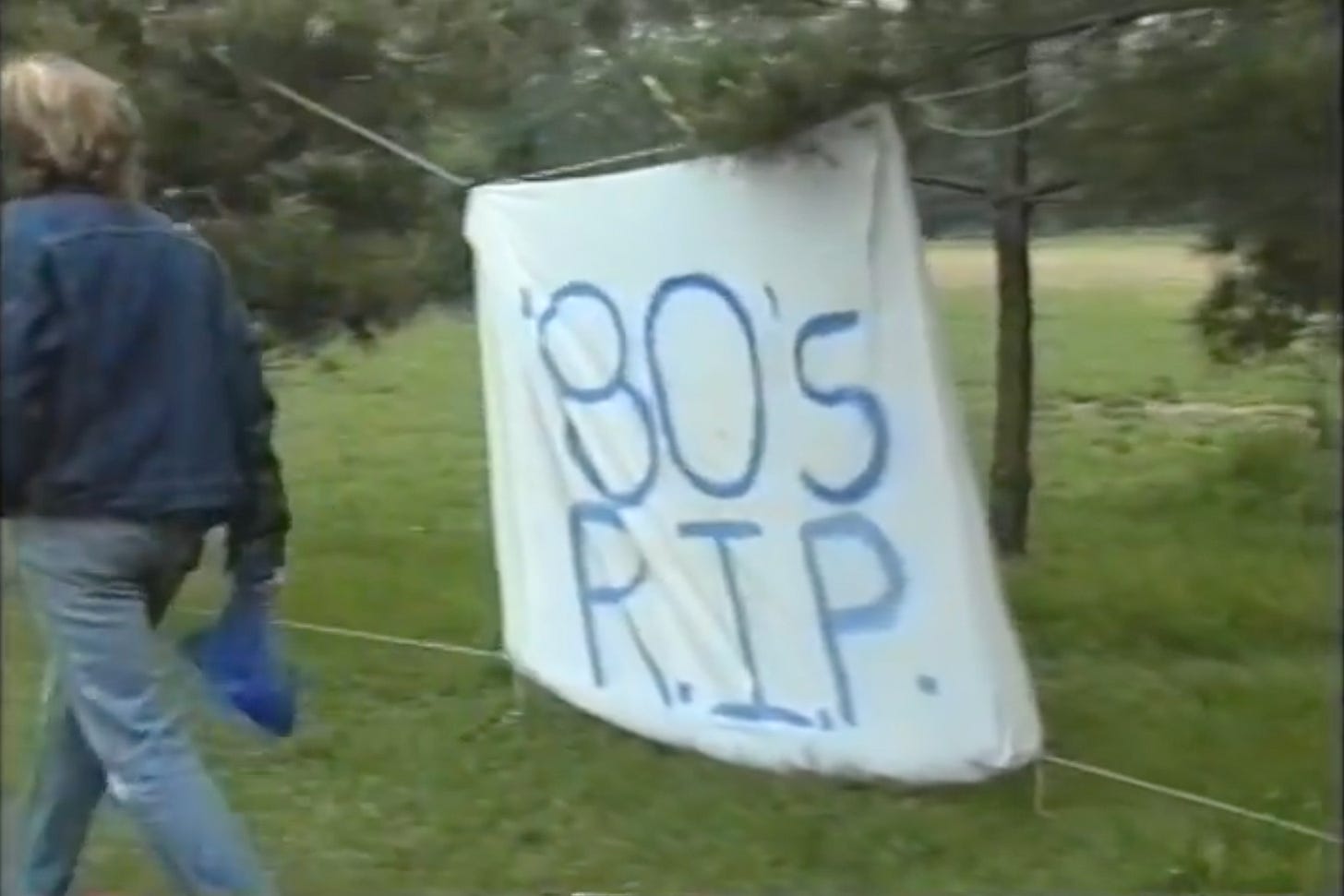Picture this: the year is 1988. You are a native New Yorker, you’ve seen it all. Or so you thought, as you sit in Central Park watching a curious scene unfold. Before you processes a strange group of men bearing a graffitied coffin containing items such as a Rambo doll, a piece of the Berlin Wall, and a little baggie of fake crack. Strangest of all, the men are completely bald, earless, and painted Yves Klein blue. Only in New York, surely.
Except not only in New York. Somehow, this demonstration grew into multiple full productions, the Blue Men multiplying and popping up at residencies in Boston, Chicago, Las Vegas, Orlando, Berlin, and Shanghai (and previously, Sydney, Toronto, Tokyo, Vienna, Amsterdam…I could go on). Back in New York, the Blue Men have been continuously occupying the Astor Place Theater for over three decades, longer than the current longest running show on Broadway. But why are they here? What does it all mean?
The success and longevity of the Blue Man Group is truly remarkable when you think about it. Now, I don’t blame you if you don’t think about the Blue Man Group very often, or even at all. I was once like you, too. What I knew about the Blue Man Group is what I assume most know. They are a group of men, painted blue, who engage in musical performance art with a sort of avant-garde flair, and they have those big drums that splash the paint everywhere.
Ever the art snob, my views of the Blue Man Group were colored by my limited encounters with their billboards and advertisements, primarily in kitschy tourist areas like Las Vegas and Orlando. I placed them in the same category as acts like Criss Angel and Carrot Top: entertainment to delight the masses, fodder for satirist writers on The Simpsons and SNL.
But I spend a lot of time on Wikipedia. And having found myself on the Wikipedia page for the Blue Man Group, my assumptions were challenged and my curiosity piqued. For whatever reason, I wanted to dig into the art of the Blue Man Group, search for its meaning, and understand why they have captured the attention of audiences around the world for decades. Although not nearly at their peak popularity, the Blue Man Group is still commanding a sizable audience, and for a multi-decade long artistic endeavor that is no easy feat. I even checked out a few upcoming dates for Blue Man Group shows in New York, and was surprised to find very few available seats weeks, even months in advance. So, I set out to learn more.
Two weeks after I started this journey, I give you everything I know about the Blue Man Group.
Origins
A trend forecaster, an acting student, and a software producer walk into an apartment on the Upper West Side. This isn’t a set up to a joke: it’s Chris Wink, Phil Stanton, and Matt Goldman, the founders of the Blue Man Group. Roommates Wink and Goldman would host salons in their apartment with their artist friends, Stanton among them, where they would showcase their art and workshop ideas. One night, Stanton arrived with blue paint smeared all over his head. The consensus was it was an interesting idea, but his hair looked weird. One bald cap later, the Blue Men were born.
The next challenge was turning this nascent idea into something a bit meatier, something that makes a statement and gets people’s attention. The eighties were dead, they decided. And if you say something loud enough and enough people listen, that makes it true. So the Blue Man Group held its first “happening” (as they called their public performance art demonstrations): a funeral procession through Central Park memorializing the pop culture scene of the 80s. On a whim, they invited MTV reporter Kurt Loder to cover the event, and he added some legitimacy to their message.
“He made it seem like if you missed this thing, you were a loser,” recalled Goldman in an interview with Vulture.
The Blue Man Group was gathering momentum, holding several other “happenings” in this era and gradually developing the characters and concept we know today, as well as a cult following. Early on it was decided that the Blue Men should be nonverbal characters, and they adopted a stagehand-chic all black uniform.
In 1991, after years of developing the concept, the Blue Man Group debuted its first production called Tubes at La MaMa, an off-off Broadway experimental theater club. By November of that year, Tubes was moved to the Astor Place Theatre, where the Blue Man Group still performs today.
Substance
A full-scale Blue Man Group production is a far cry from a guerrilla-style performance art demonstration through Central Park, and it's in the themes and messages of these productions that we can begin to dissect the intentions of the Blue Men.
Let’s begin with the Blue Men themselves. What is a Blue Man? According to the Group’s artistic director Randall Jaynes, “The closest answer you can get is it is the other. It is the outsider.”
A Blue Man Group show is a window into the perspective of the total outsider. At the same time as an audience we look onto the three Blue Men who are so intrinsically linked as to look indistinguishable from one another, and it’s as if we are intruding in their world. We are the outsiders to the outsiders. Tubes highlights this by opening the show with the Blue Men staring down the audience, creating a sense of alienation. The entire arc of the show centers around resolving this alienation, bringing the audience into shared community with the Blue Man Group, inviting them to understand these outsiders. This is achieved through musical performance and audience participation, with interluding demonstrations of strange but oddly charming behavior from the Blue Men. By the end of the show, the connection developed among the audience and the performers is represented literally by a web of connective tissue made of paper streamers.
To understand how this is achieved, we’ll discuss first the interluding skits, because they do serve to tell us a lot about the Blue Men as characters. As nonverbal characters, the Blue Men must be able to “wordlessly emote,” which all hopefuls must demonstrate during the audition process. One Blue Man recalled being told in his audition to pretend he was walking in a desert and saw a bottle of water, and to demonstrate what he would do without speaking. In this way the Blue Man Group can be compared to traditional mimes or clowns, who draw upon centuries of tradition to convey certain characters and scenarios to audiences using a visual shorthand.
The Group has developed six archetypes of Blue Man: innocent, hero, scientist, shaman, group member, and trickster. Any of the three Blue Men may take on any of these roles throughout the course of a show, although there are certain archetypes that are grouped together. For example, the hero’s role is to act on something and make a change, the innocent’s role is to react to this change. When the Blue Men are working together as group members and one acts out, he becomes the trickster. These archetypes serve to differentiate the identical looking characters onstage as the audience learns they can act independently of one another.
At the same time, having limited options for reactions and behaviors of the Blue Men adds to their uniformity of character. One Blue Man can be the hero one moment and the innocent the next, they are designed to have no distinguishably unique personality. This plays into a collectivist/individualist theme present throughout Blue Man Group shows. Despite being three separate individuals who can, if necessary, act separately from one another, the audience learns throughout the show that by working together, the Group can achieve more, and by working together and with the audience, even more absurdist fun is possible.
Familiarity/unfamiliarity is a central theme as well. The Group’s ultimate goal, as outsiders, is to understand our world. Throughout the show audiences see familiar objects used in different and innovative ways, implying that the Blue Men have come up with their own ideas for the functions of our objects. Marshmallows, for example, are used not for roasting by a campfire but thrown at incredible distances and caught in one Blue Man’s mouth, over and over, until the absolute limit for how many marshmallows a mouth can hold is reached.
This familiarity/unfamiliarity theme extends into the music of the Blue Man Group as well, which, more than other musical groups, is intrinsically linked with its performance. While the Blue Man Group is technically known as a musical group, with three studio albums and even a few appearances on movie soundtracks (Robots and Space Chimps, for the curious), there really is no denying that the allure of their music comes from the visual spectacle of seeing it performed.
Given that the Blue Men never speak, their music is entirely instrumental, save for some rare disembodied voice over. It’s also largely percussion based, and many of the instruments used are made of everyday objects, like oil drums and PVC pipes, again reimagining the familiar to serve a new purpose. The music that results from these strange instruments is unusual, sure, a little industrial and futuristic, but still at the end of the day, music.
These instruments also bring together other themes of the show, like individualism/collectivism. There are certain instruments, like the “drumbone,” which require all three Blue Men to work together in order to play. This is totally lost on the listener, but to the viewer there’s a clear message of community and cooperation. Therefore, the Blue Man Group is a musical group that must be seen in order to be really heard.
It’s hard to put into words, really. A better sense of their music would be gained from watching a performance, and I believe the Blue Man Group’s Tiny Desk Concert from NPR does a good job of capturing what makes them unique in a shorter format.
The Tiny Desk Concert also demonstrates how the Blue Man Group’s unique approach to audience participation adds to the atmosphere and energy of their shows.
Audience participation is inherently quite an uncomfortable thing. Audience members are reluctant to volunteer, and those brave enough to step forward are left in a vulnerable position of uncertainty in front of a crowd of expectant eyes. Unless you’re my attention-seeking self, this is not a comfortable situation. The Blue Man Group is keenly aware of this, and in fact leans into the discomfort and nervous energy this creates.
We see this clearly in the NPR video during the guided dance segment. Two audience members are singled out for the segment, though the rest of the audience is encouraged to follow along as a disembodied voice delivers instructions. The audience is asked to partner up and get increasingly closer to their partner, physically putting their hands on their shoulders. Okay, not too bad, not crossing any major social boundaries yet. Then they’re asked to open their mouths and stick out their tongues, increasing the discomfort factor. Finally, the audience is told they’re ready for dragon breath and to breathe out into their partner’s face. Ewgross! Clearly, no one wants to do this, but the voice said so and they’ve already come this far, so through grimaces and awkward laughter everyone gives a half-hearted attempt at dragon breath, finding the compromise between complying with the voice and adhering to social norms. In the end, the audience has been successfully nudged out of their comfort zone, literally only because some Blue Men told them to.
Audience participation is a major part of Blue Man Group stage shows, and thematically it plays a crucial role in conveying certain messages within the show. The participant’s often palpable discomfort highlights the otherness of the Blue Men, their silent stoic demeanor doing little to put nervous participants at ease. Audience members might be asked to come onstage and become a living canvas, or have a camera pointed inside their mouth for a mock dental exam. One musical number, “Audience Probe” sees the Blue Men setting off into the audience with cameras and microphones, recording bits of audio and video to be used in the song itself. At any point in a Blue Man Group show, the audience is never guaranteed to be safe from becoming part of the show itself. This is made clear to the audience from the moment they set foot in the theater and see ponchos draped across their seats, the message being: get ready, this isn’t going to be your typical theater experience.
Most people would probably hate to be picked as the audience participant, but people love watching audience participation. It’s spontaneous, it’s risky, and it makes every show unique. If someone in your party is chosen to participate, it creates a funny anecdote to be shared over and over again for years to come. It transforms the audience from passive spectators to active participants, and turns the show into a “you had to be there” experience. I believe this is a big reason why ticket sales are still so strong. This element of audience participation makes for a show people hear about through word of mouth and are willing to experience again and again because truly, anything can happen.
And of course, audience participation is crucial to progressing the storyline of the show as well. Through interacting with the audience, our Blue Men seem more like our weird quirky friends than total outsiders, and audience participation helps them understand more about our world in the context of the show.
The Blue Man Group puts on a weird little show. Part vaudeville, part rock show, part performance art showcase; there’s really nothing to rival it. It’s like it was created in a lab to be as entertaining and stimulating as possible. With themes of discovery, acceptance, creativity, and cooperation as well, the show conveys a positive message that audiences of all ages can learn from. Founders Wink, Stanton, and Goldman turned an interesting concept into a must-see show, and with the power of well-trained, incredibly talented performers this show has been continuously successful for decades.
Evolution
So we’ve established that the Blue Man Group has successfully captured the attention of audiences in a unique way. This is challenging enough, and maintaining this success for over thirty years is practically miraculous, but through careful protection of their brand image, adaptation to changing audiences, and a huge team of dedicated creatives, the Blue Man Group has made it happen.
Originally, there were only three Blue Men: Wink, Stanton, and Goldman. In 1993, the first understudy was trained, opening up a world of possibility for the Group. Today there are 70 active Blue Men in the world, but more than 200 performers have taken up the role in the Group’s history, all of whom passed a rigorous audition and training process in order to join.
Blue Man hopefuls must be skilled drummers, between 5 '10 and 6' 1 with an athletic build, and as mentioned before, capable of “wordlessly emoting.” There are no race or gender requirement to be a Blue Man as long as the aforementioned requirements are met (Andrea Johnson is the only woman to have ever been a Blue Man, active from 1999 to 2001). These auditions are highly competitive, with only one out of every 1,200 auditionees making the cut.
The ability to audition and train new group members in the Blue Man method allows the Group to run multiple shows simultaneously around the world (take that, Mormon Tabernacle Choir). It also prevents performer burnout, as the Blue Men have more freedom to take time off for illness or vacation without disrupting other members of the team.
As the popularity of the Blue Man Group increased, they were able to scale up to meet demand. Productions opened in Boston in 1995 and Chicago in 1997, later followed by a huge success at the Luxor in Las Vegas in 2000. Given that the show had little dialogue, it was easily adapted to international audiences as well, beginning with Berlin in 2004 (of course the Germans dig the Blue Man Group, those freaks). Although the Group has scaled back somewhat from at one point having ten concurrent shows running worldwide, with strict guidelines that ensure the consistency and quality of shows globally, the Blue Man Group has demonstrated it can easily meet its demand in any market.
The Group is also a great example of the idea that all press is good press, and in some ways their tongue-in-cheek sense of humor has made them almost satire-proof. They’re like that weird kid in school who didn’t really get that people were making fun of him, or at least took it in stride, so eventually people just let him in on the joke.
My favorite example of this comes from my favorite show of all time: Arrested Development. In Arrested Development (a show about the downfall of a dysfunctional upper-class family in Orange County), disgraced therapist-turned-aspiring-actor Tobias decides he’s going to join the Blue Man Group after mistakenly attending a show, thinking it was a support group for men with depression. This storyline is woven across multiple seasons of the show, and is responsible for some of the best jokes in the series, but if you watch closely you’ll notice none of the jokes are at the expense of the Blue Man Group. The punchline often comes from Tobias’ absurd dreams of stardom and his misguided attempts to kickstart his acting career, while the Blue Man Group comes across as almost too strange to make fun of, an entity all on its own. We do see an official appearance from the Group in the show, when the patriarch of the family George Sr. hides out among them as a performer while on the run from the law, and he plays his role in the Group very seriously.
The Blue Man Group has appeared on several late night shows and in commercials, performed at sports games, and were once even called “a rip off of the Smurfs” by Homer Simpson. Their strange appearance makes them memorable, an easily recognizable representation of a kind of silly form of art, so the Group is referenced somewhat frequently in pop culture and the media. These references do far more to increase the reach and recognition of the Group than to disparage their legacy and work, I can’t recall having anything but positive or neutral reactions to seeing the Group referenced in the past.
Finally, the endurance of the Blue Man Group can be evaluated by its ability to survive after the departure of its founders. Goldman sold his share of the group in 2010, with Wink and Stanton following suit in 2017. The Group is now owned by Cirque du Soleil, with none of the original founders having any significant involvement. Still, the show goes on.
“It’s not a blow to the ego that they’re able to do it without us,” says Wink, “That’s part of what’s satisfying.”
The fact that the Group survived the pandemic is further proof that the show is still going strong, and as I mentioned earlier tickets aren’t always easy to come by. The show doesn’t really follow or show influence by any trends, it’s not outwardly political, and audiences have consistently praised the unique performance and atmosphere the Blue Man Group creates. It’s a formula that works, and one that can be replicated again and again, anywhere the Blue Man Group is wanted, for as long as the Blue Man Group is wanted.
Future
It seems they’ve got a good thing going then, the only question left is how long they can keep it alive. There are some works of art that have been continuously appreciated for hundreds of years, like Michelangelo’s David and the Mona Lisa. There are some that were once considered must-see spectacles, but changing trends over time have left them somewhat dated, like Hamilton (an essay for another day). I believe the Blue Man Group still has a few more years of relevance left, though the exact number I couldn’t tell you. At some point, enough people will tire of the Group that ticket sales will slow and the company will eventually dissolve. This, I fear, will be the end of the artistic legacy of the Blue Man Group. Live performance is such an important element of the Blue Man Group concept that its art can only survive as long as it is being continuously performed live. So, reader, I urge you, go catch a Blue Man Group show while you still can.
In the words of Chris Wink to Kurt Loder on that fateful day in 1988, “pop culture just burns so fast, like a bad coke trip.” It was perhaps in recognizing this that Wink and his fellow co-founders were able to capture something with the ability to burn much slower, quietly in the background across multiple decades and throughout some of the most rapidly changing times in history. To create a show that captures the human spirit so elegantly in such a non-human form, reminding us that the most important thing we have in life is our communion with those around us.
Sources:
“Blue Man Group New York - Voices”
“Robots (2005) - Blue Man Group” DVD bonus features
“What it Takes to be a Blue Man” Insider
“‘Blue Man Group’ Review: The Absurd at its Best” Xander D. Patton, Harvard Crimson Review November 21, 2023.
“How Blue Man Blew Up” Molly Langmuir, Vulture, March 28, 2022.
“Coloring the World Blue: The History of the Blue Man Group” Stiffel Theatre, Apr. 2 2014.
And Wikipedia, shut up it’s my essay I can source what I want.
Sorry, the longer this got the funnier it became to me.







